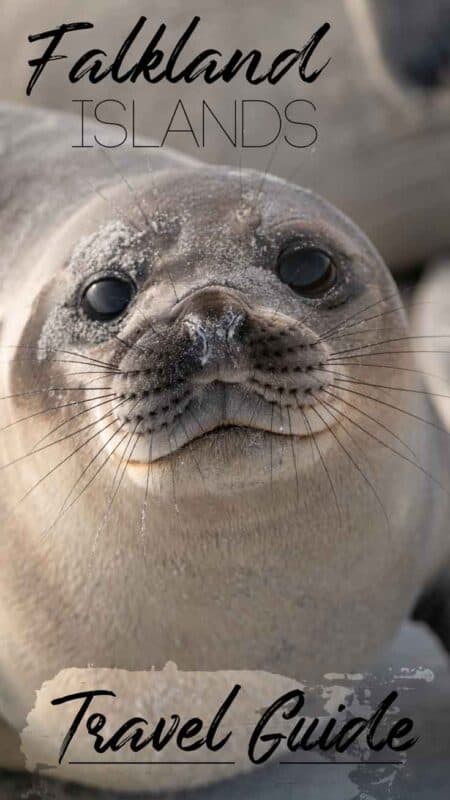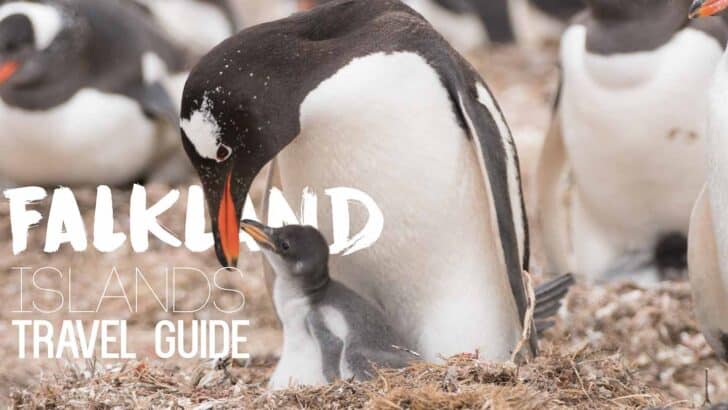The Falkland Islands are one of those rare places left where you can escape the modern world. Located 300 miles to the east of the bottom tip of South America.
Their remote location has left the Falklands a place for one-of-a-kind wildlife encounters. While the fauna is what draws most this far south, I think what truly makes the islands special is the chance to glimpse into a unique way of life and, most importantly, a place to explore.
The longer I stayed, the more the outside world seemed to almost melt away. With each passing day spent on the islands, the pressures of everyday life seemed less important. Things are simpler here – in a good way.
Everything is extremely practical in the Falklands, almost to a fault, but fault is the wrong word because the practicality is one of the Falkland’s greatest charms. Things are the way they are mostly because they have to be – but it also makes you wonder if it isn’t because this is the way things maybe should be.
After a few days on the islands, I began to realize that this is a very DIY place. Everyone kind of does everything. The same person who checks you into the lodge is also the person serving breakfast. That’s far from the end of their duties.
They are also the ones to take you to the airstrip. They are also hooking their Land Rover to the fire station because they are the firefighters too. These are only a few of the hats most Falkland Islanders wear.
Of all the places we’ve visited in recent years, the Falklands are unlike any of the others – and I think that is what I grew to love about the Falklands the most. Sure, the wildlife is amazing, and I would return just for that alone, but something about the way of life here in the Falklands I found equally as interesting.
Jump to Info:
- Falkland Islands History
- Getting into the Falkland Islands
- How to get around the Falklands
- Falkland Islands Itinerary & Destinations
- Falkland Islands Tips & FAQ
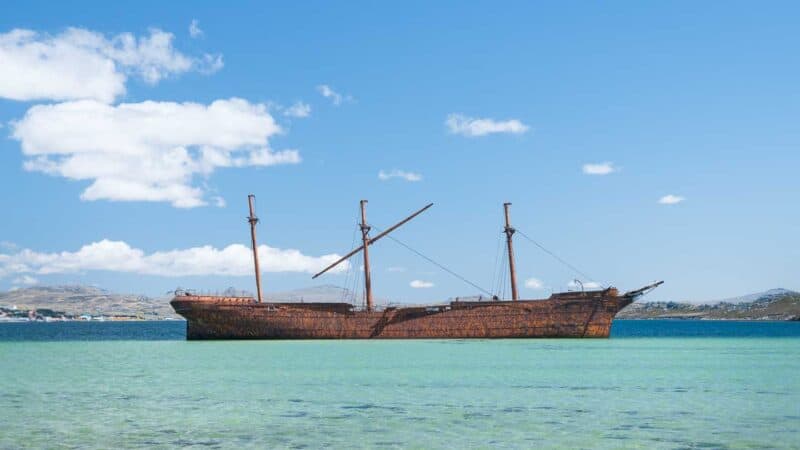
Brief Falkland Islands History
The earliest recorded history of activities on the Falklands was in 1690, when English captain John Strong discovered the islands while traveling around the tip of South America. It’s debated if earlier sailors had previously found the islands before Strong or possibly the indigenous people of Patagonia, but Strong is credited in the history books.
However, the islands remained uninhabited until 1764, when the French founded Port Louis, and two years later, the British established Port Egmont on Saunders Island.
The next 100 years would see settlements come and go, but a few took hold in the 1850s when sheep were successfully introduced. The Falklands also played a role in the shipping trades until 1914, when the Panama Canal opened. A trip to the National Falklands Museum is a must to learn about even more surprising pieces of history, like their WWI battles.
Today, a total population of around 3,300 people calls the Falkland Islands home. They share the islands with a few million sheep and some amazing wildlife.
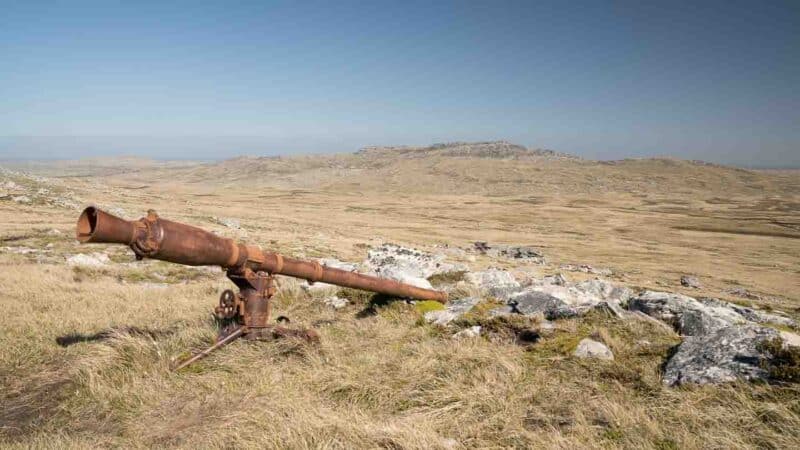
The Falklands War of 1982
I don’t want to dwell on the war, but I wanted to put a foreword in case you are not very familiar with the conflict, and it’s an important piece of history. In 1982, Argentina sent around 11,000 troops to occupy the Falkland Islands, claiming them as part of Argentina.
This claim goes back to the time of the Spanish conquest of the New World and then Argentina’s claim to Spain’s territories in the South Atlantic in 1816.
In the second half of the 20th century, the Falklands became the focal point of a political move Argentine President Juan Perón attempted to assert sovereignty over the Falklands. He used the Falklands to rally the population around a common cause, which all came to a head in 1982.
The British responded by sending 5,000 troops from various divisions, including many special forces, to take back control of the islands. The result was a 74-daylong conflict. During the fighting, nearly 1,000 people lost their lives – 649 Argentine soldiers, 255 British Soldiers, and three Falkland Islanders.
Often, when discussing the Falklands, most people gravitate toward the War of 82’. While it had a big impact here in the Falklands, there is so much more to a trip to the Falklands than war history.
Here is our recap of our recent trip and a Falkland Islands travel guide to help plan your trip. At the end of the conflict, the Argentine forces surrendered, and the Falkland Islands remained a British Territory.
Getting To The Falkland Islands
From the USA, Europe, & Other Locations – The best way to get to the islands is via Santiago, Chile. There is one flight per week from Santiago to Mount Pleasant Airport, which is currently the main commercial airport.
Every Saturday, LATAM/LAN flies to the Falkland Islands from Santiago with a stopover in Punta Arenas, Chile. You can also book the flight from Punta Arenas if you are already traveling in Southern Chile.
As a note, you will need to disembark the plane and clear Chilean customs in Punta Arenas. The process was simple and routine. We recommend booking flight legs independently rather than searching for flights from your home country to the Falkland Islands directly.
Also, be sure to leave enough time between your return flight from the Falklands to Santiago in case of weather delays that do happen infrequently.
Update: 2nd Weekly flight has been added from Sao Paulo, Brazil, every Wednesday.
From the UK – The best way to get to the Falkland Islands from the UK is by the RAF Airbridge, which runs frequent service to the islands. Every Sunday and Wednesday, flights depart from RAF Brize Norton in Oxfordshire. The journey takes around 18 hours, with one stop on Ascension Island. This option can be a little bit cheaper than commercial airlines. To Book: +44 (0)20 7222 2542
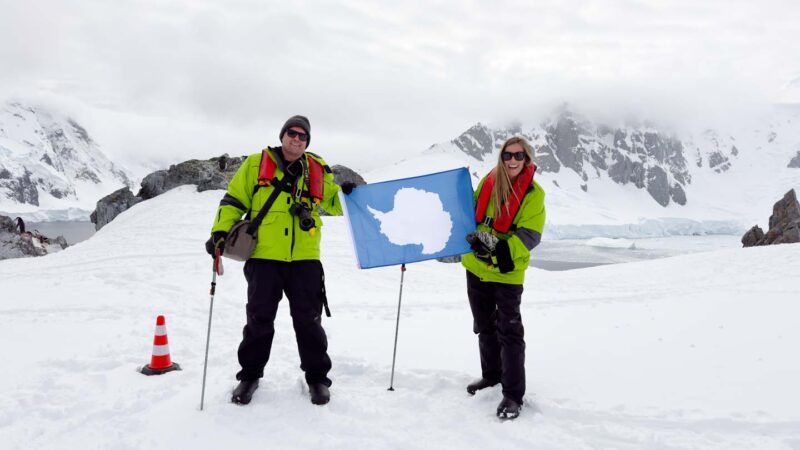
Antarctica Cruises with Falkland Island Stop
If you are looking into Antarctica Expedition Cruises, look at the longer cruises that include stopping in Antarctica. Depending on what specific itinerary you choose. There are Antarctica cruises that include visiting the Falkland Islands for 1-3 days.
The cruises that include the Falkland Islands are usually 12+ nights like this one. We went on the classic 9 night Antarctica cruise, as we couldn’t leave our two toddlers much longer than that. We had an amazing trip and next time we want to visit South Georgia & Falkland Islands.
Related Article: What To Wear In Antarctica – Clothing Packing List
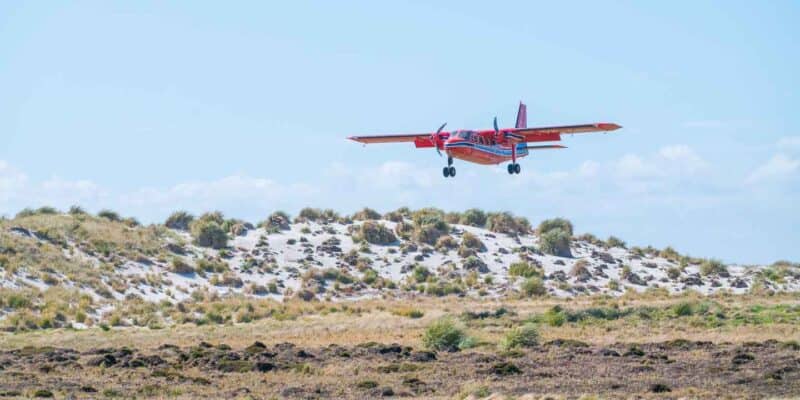
Getting Around the Falkland Islands
The best way to get around the Falkland Islands is by the little red FIGAS planes. The Falklands government runs several flights per day around all of the islands.
To make bookings, you just need to email them. The flight schedule is assembled the day before your flight, and you may have a few short stops on your way to your destination.
Before you are put off of flying small aircraft, these pilots and planes are quite impressive. I personally always dread flying in small planes, but these are just different. After my second or third flight out of six, I no longer worried during the flight. I actually enjoyed them, and it’s usually a very scenic flight.
The planes handle the generally windy conditions very well, and the pilots do a great job avoiding the bad weather. The result is a pretty good flight in some poor conditions at times.
Top Destinations for a Two Week Itinerary in the Falkland Islands
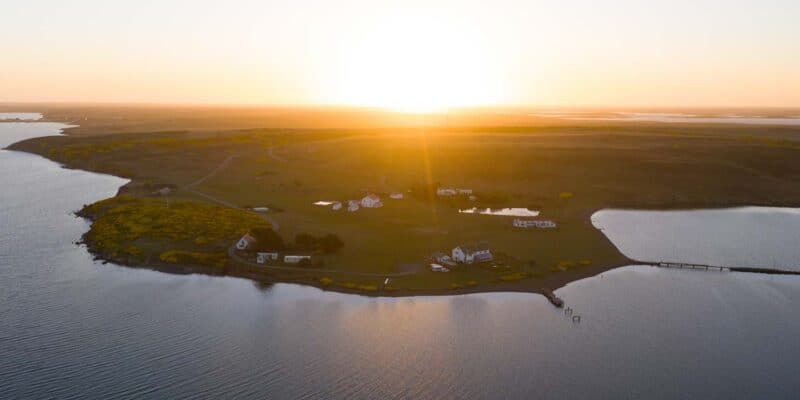
Darwin (1-2 Nights)
A long, dusty gravel road runs from the Mount Pleasant Airport toward the quiet settlement of Darwin. Comprised of just a small cluster of white houses topped with traditional green iron roofs surrounded by bright yellow gorse bushes, this would be our first taste of the Falkland Islands.
Our trip to the Falklands started here in the Darwin settlement to get a better understanding of a few of the important battles that took place in the Falklands War in 1982.
In addition to some important recent history, this settlement is surrounded by natural beauty. Just a little way in the distance is Mt. Osborne, the tallest point in the Falklands. The sunsets here are great in this peaceful setting. Standing in front of the Darwin Lodge, watching the sun colorfully set over the still landscape, it’s hard to imagine anything bad ever happening here.
How much time you want in Darwin will depend mostly on how interested you are in the war history. Many of the highlights here revolve around the war. It’s a great place to get a better understanding of what took place during the conflict of 82′ in the Falklands.
Top Things to Do in Darwin, Falkland Islands
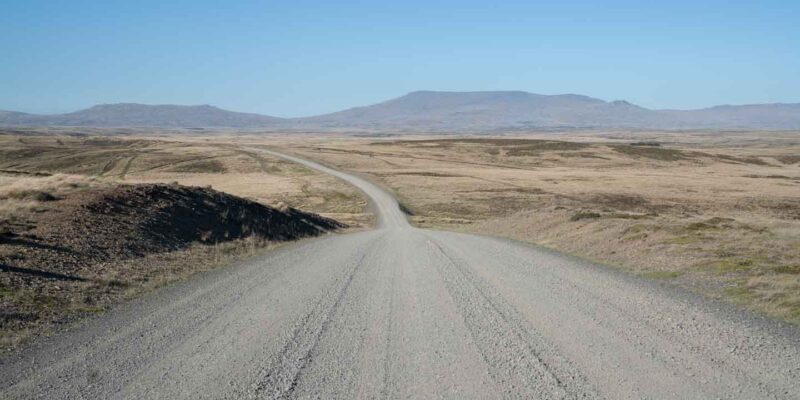
Battlefield Tour – The gently sloping grass-covered hills surrounding Darwin were host to some of the fiercest battles of the war. During our time in Darwin, Anton, the manager of the Darwin House, took us around by Land Rover to where the fighting took place in 82’.
As we blazed our own trail on the trackless hills, our guide painted a picture for us of what the landscape looked like the night the British troops took back the hills outside of Darwin. The Argentines were dug in positions on the hilltops with machine guns and mortars. The British 2 Para Division stormed the positions, taking them one by one after marching through the night to reach them.
As the fighting raged on, it took longer than expected to reach and clear the hilltops, and the British troops lost the cover of darkness. Still, they heroically forged on – eventually forcing the remaining Argentine soldiers to surrender. In the process, they took several losses, including one of their leaders, Col. H. Jones, who fell in the hills just outside of Darwin, the spot now marked with a memorial.
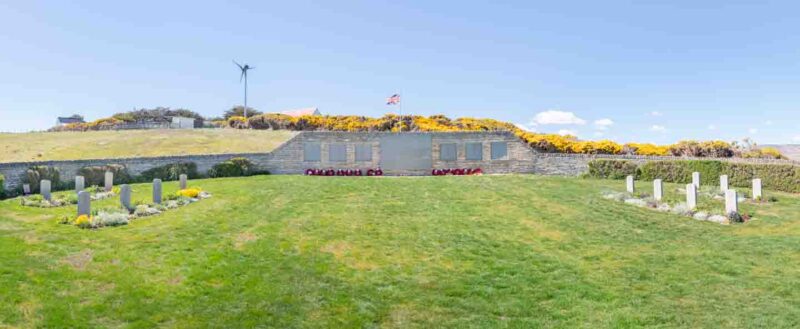
British Memorial – To commemorate the sacrifices made by the soldiers, there is a memorial overlooking the water in San Carlos near where the British troops first landed. Here, all of the soldiers & sailors who lost their lives defending the Falklands are remembered.
Here, a nicely manicured garden surrounds the grave markers, and just in front of the memorial is an excellent view overlooking the bay.
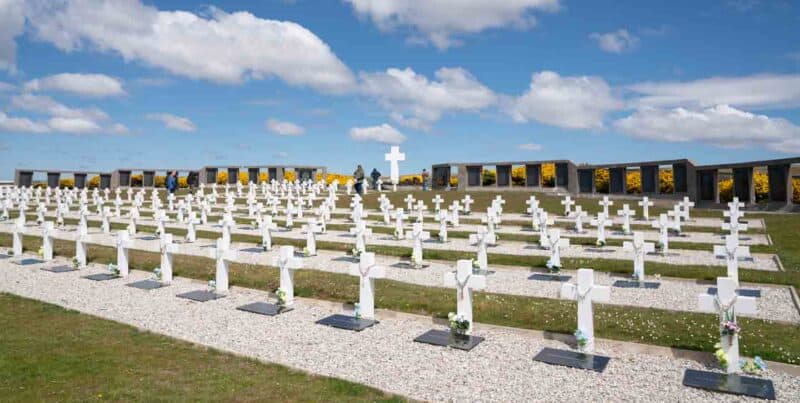
Argentine Memorial – There is also a memorial for the Argentine soldiers who died in the war. At the time they were buried, they were not able to identify soldiers, and many graves were marked by “Argentine Soldier Known Only by God.”
However, in recent years, DNA testing has been done to identify the graves of previously unknown soldiers properly. The focal point of this memorial is a large white cross that looks over all of the grave markers.
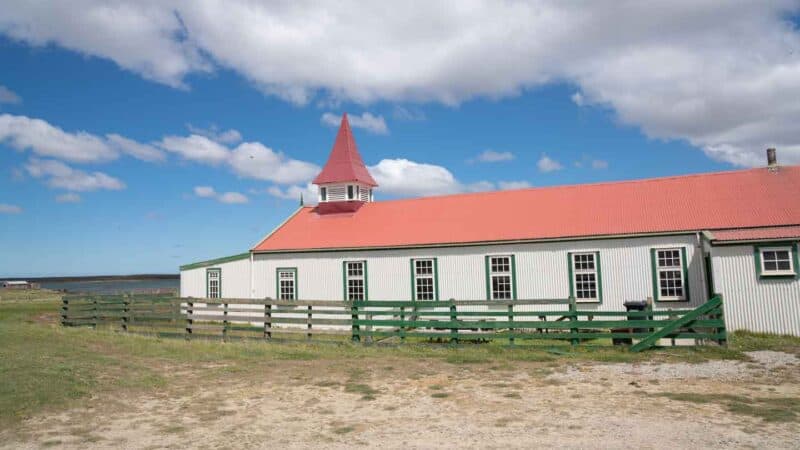
Goose Green – Goose Green was also another turning point in the war. Here inside the local community center, most of the nearby residents were held captive by Argentine troops for more than a month during the conflict.
The Argentines feared the settlers were relaying information back to the British troops, so they kept them confined to the small community center. In modern times, there is a war museum dedicated to the regiment of soldiers from the 2 Para division who liberated the town.
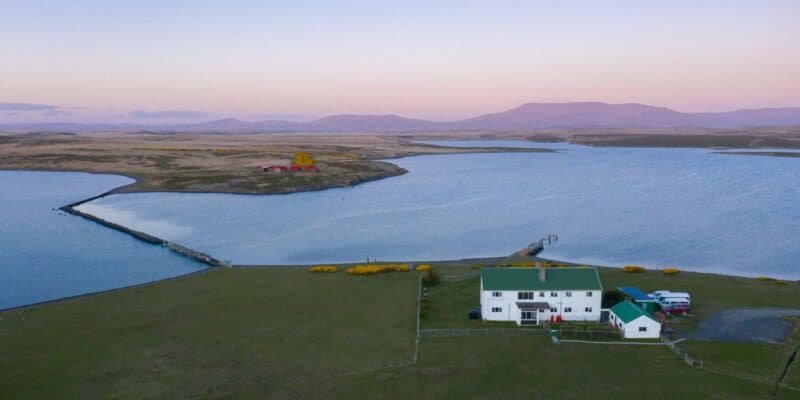
Mt. Usborne – A few miles to the north of Darwin is the tallest point (2,313 feet / 705 meters) in the Falklands, Mt. Osborne. In the evening, it glows pink when the skies are clear as the sun slowly sinks into the hills surrounding the small settlement.
Where to stay in Darwin – We stayed at the Darwin Lodge, which was one of the nicest lodges we visited during our trip.
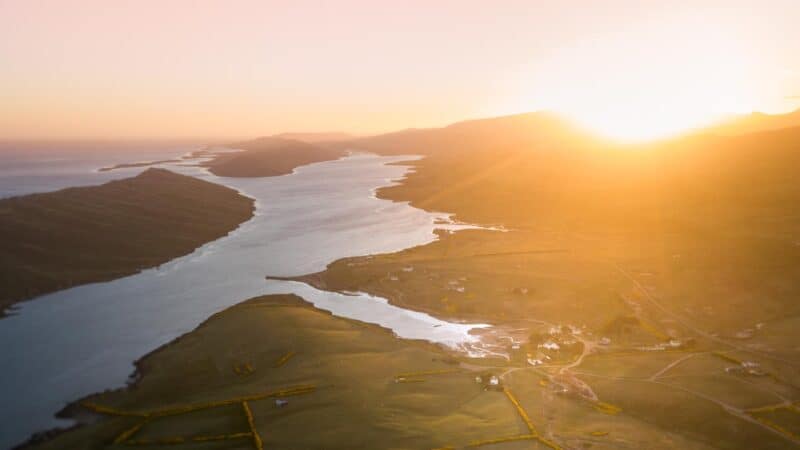
Port Howard (2 Nights)
The second stop on our tour of the Falklands was the settlement of Port Howard, which is one of the largest settlements in West Falkland, with around 100 people. The large community living here is a unique chance to see ‘camp’ life in the Falklands. There are also a handful of activities in and around the town that are unique to the area.
Due to the flight schedules, the only way you’ll be able to take a fishing trip and see some of the area highlights is to spend two nights here. Anything less than that, you might not get to see much.
Top things to do in Port Howard, Falkland Islands
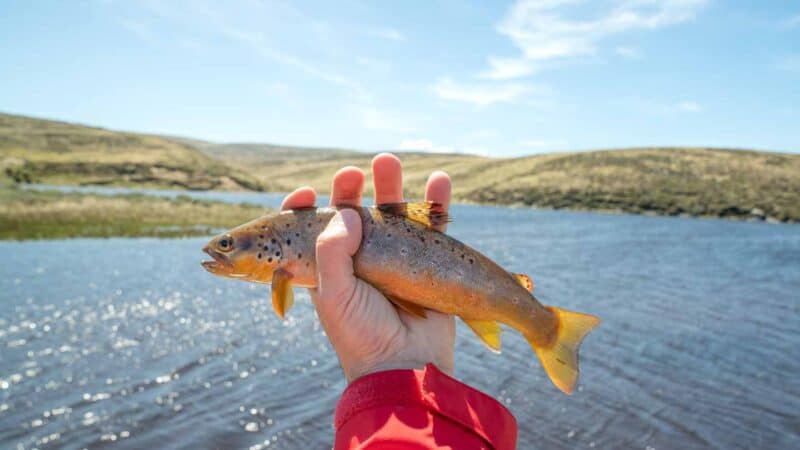
Trout Fishing – One of the top activities in Port Howard is a trip out to the Warrah River for some very good Trout fishing. We went out on a day of fishing on the Warrah with a local guide, who was also our host at the Port Howard Lodge, Wayne Brewer. He set us up with equipment, and we made the drive out to the point where the Warrah River met the sea.
From here, we cast our spinning bait into the shallow rocky portion of the river in hopes of pulling in a big trout. During our visit, the conditions were not in our favor, but we still managed to reel in a few nice trout. Even though we didn’t land a monster, it was still a nice day in a very scenic part of the Falklands.
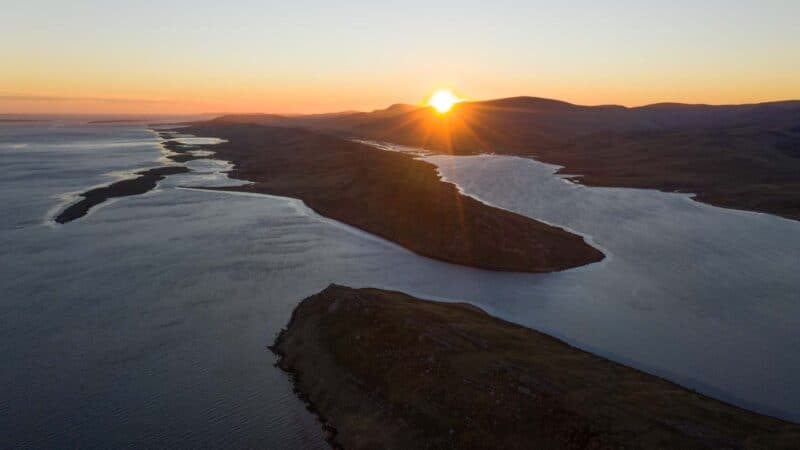
The Narrows – The bay of Port Howard is formed by two massive rock walls standing between the settlement and the sound that divides East and West Falkland. Between those walls is a small gap, which is known as the narrows.
The unique geography provides a very calm harbor and provides shelter for boats and marine life. From the dock in Port Howard, you can often spot dolphins cruising around the harbor. The sunsets here are also pretty amazing.
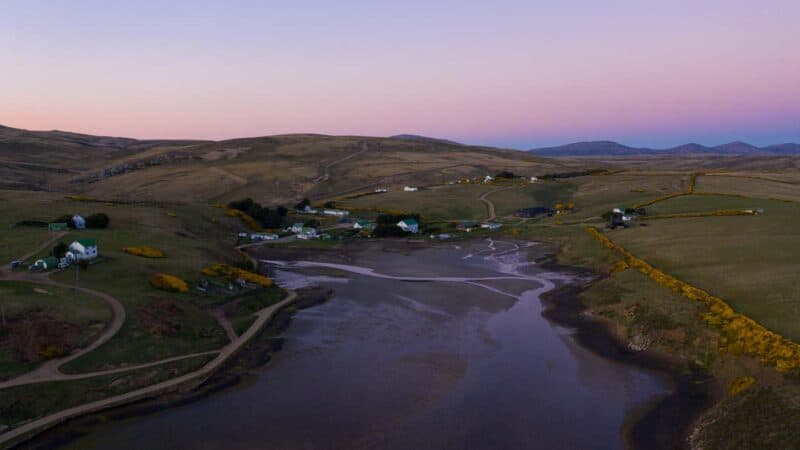
Exploring the Settlement – Be sure to take some time to walk around and see what life is like in this small community. During my time walking around the town, there were two baby lambs that took a special interest in me, and every time I walked along the main road, they would run after me, following me until they lost sight of their home before they turned around.
Hikes – In Port Howard, one of the best things to do is go out and explore the many hikes around the settlement. Some of the most challenging ascend the 2000’+ tall Mt. Maria with great views of the town and some interesting rock formations. Another one not to miss is the walk along the top of the hills that form the Narrows of the harbor for more great settlement views and a look into the Falkland Sound.
Land Mines – Still, after more than 35 years, remnants of the Falklands War are still scattered around the country. Here in Port Howard, there are active de-mining efforts underway with hopes of clearing the mines in the near future.
Luckily, in the Falklands, the Argentine Forces made very detailed maps of the minefields they planted because they had hopes of settling there. So, unlike other minefields left over from wars in other parts of the world, there are known locations and mine counts – making the process much safer.
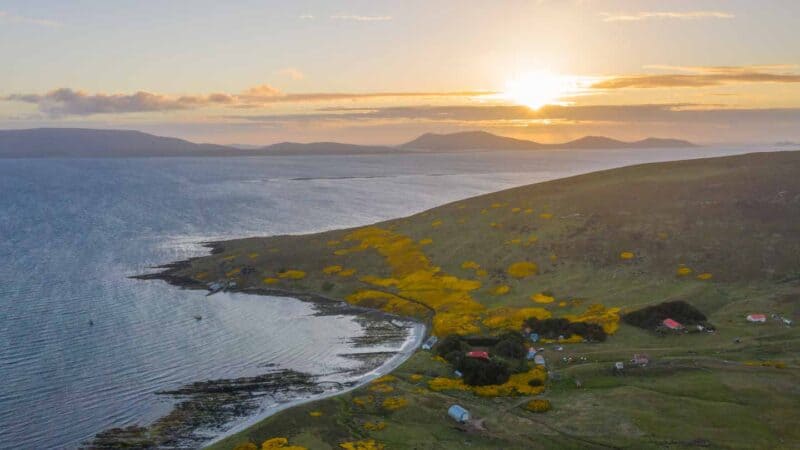
Carcass Island (2 Nights)
Carcass Island was our first taste of Falklands wildlife. Just steps from the lodge, we were on the rocky beach teeming with wildlife. Named for the HMS Carcass, the island is a favorite among wildlife enthusiasts, and it’s also a great jumping-off point to explore the Jason Islands as well as Westpoint Island.
Highlights of Carcass Island
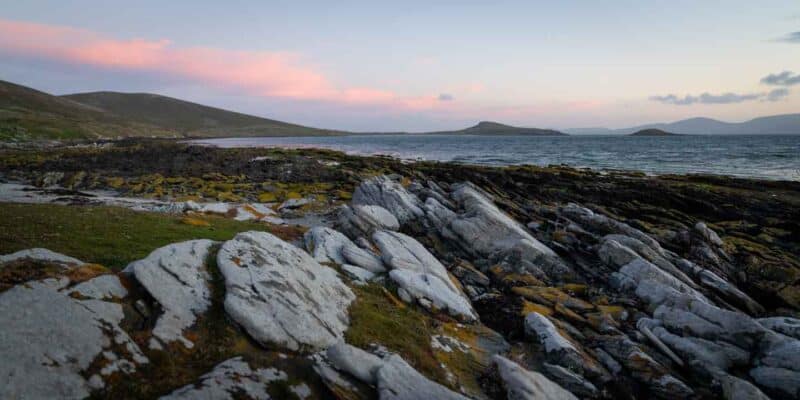
The Beach Walks – Most of the action on the island is found along the beach just in front of the lodge. Narrow tracks bring you along the length of the beach with chances to see penguins, steamer ducks, and even some endemic species like the Cobb’s Wren. If you aren’t up for a long hike, Carcass Island has plenty to see within 30 seconds of the lodge door.
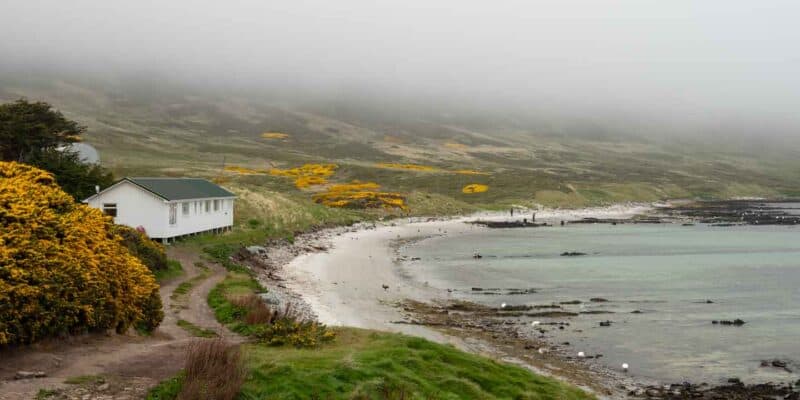
The lodge atmosphere – One of the aspects of a trip to the Falklands I wasn’t expecting was the social side of the lodges. The thing about the Falklands is that there aren’t many schedules, but if there is one important time of the day, it’s dinner time.
After a day of exploring, everyone gathers around the table, and you have people from all around the world sharing stories from their day and tales from every part of the world.
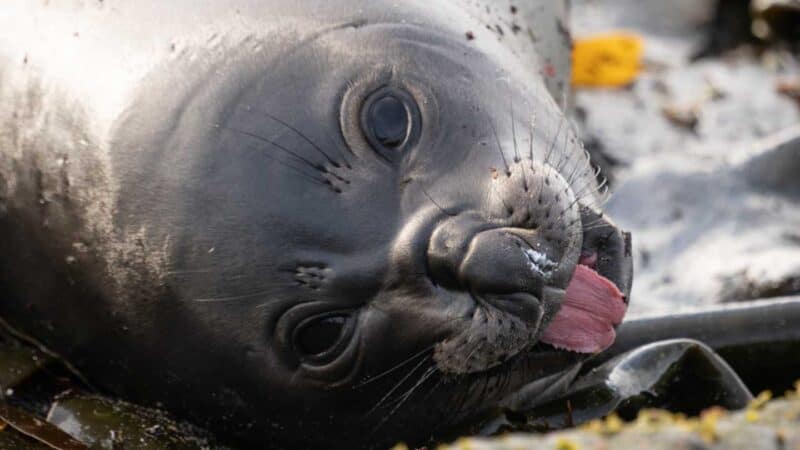
Elephant Seals – Near the airstrip, you can always find elephant seals lounging on the beach. They are generally slow-moving and laid back, and while not the most attractive, there are good photo subjects.
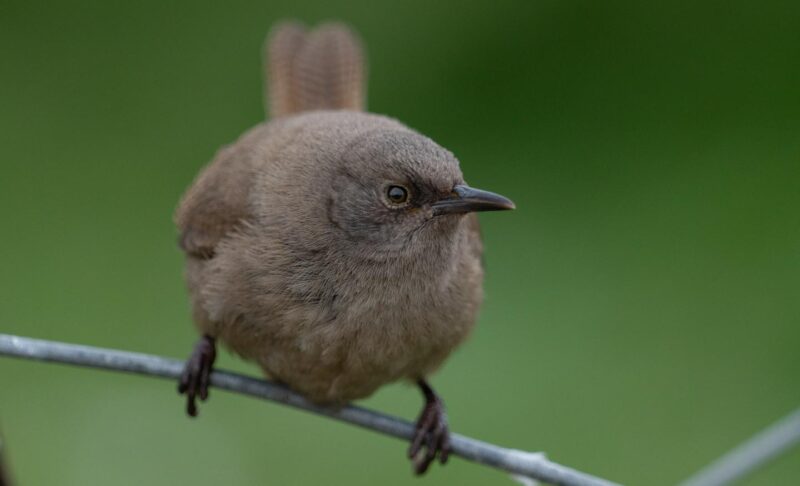
Cobbs Ren – One of the endemic species to the Island, you can find the Cobb’s wren fluttering around on the shores and trails of Carcass Island. These little brown birds are fast-moving, so be sure to have your camera ready if you happen to spot one.
West Point Island (Day Trip From Carcass Island)
Another personal highlight of our visit to the Falklands was on Westpoint Island. We took a day trip here from Carcass Island by boat to see a massive albatross colony. On the day of the visit, we were the only ones here surrounded by thousands of albatrosses.
I think this particular stop will always stick out in my mind as one of the most memorable days. Not just because of the amazing wildlife but also because we had it all to ourselves. To see something this amazing and have it all to yourself, where else in the world can you have that anymore? I think it was this day, standing on the edge of the cliffs at Westpoint, that it hit me how special the Falklands really are.
The sense of freedom here is unlike any other place I have ever visited. Of course, respecting the wildlife is required, but other than that, you are free to roam, explore, and linger here as long as you’d like.
I found myself quietly sitting all day, filling my memory cards with photos and videos of this special place. From time to time, I would set my camera down and just take in how lucky I was to not only be here but to be the only human in sight.
Must See Things on Westpoint Island
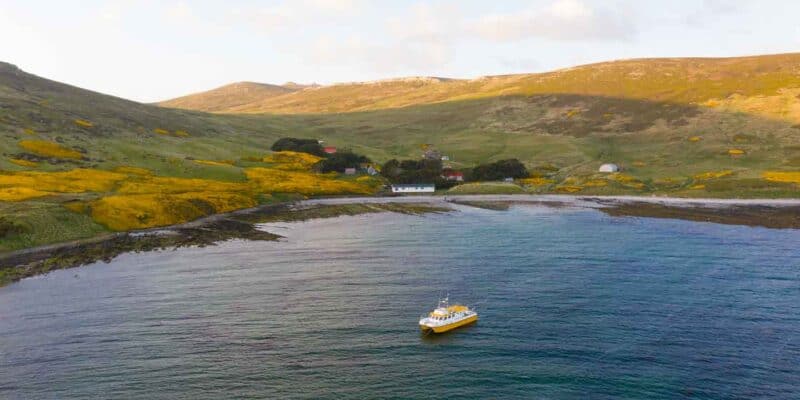
Scenic Boat ride to Westpoint – The trip over to the island is more than just transport. Along the way, we encountered stunning scenery and the chance to see other wildlife on the water.
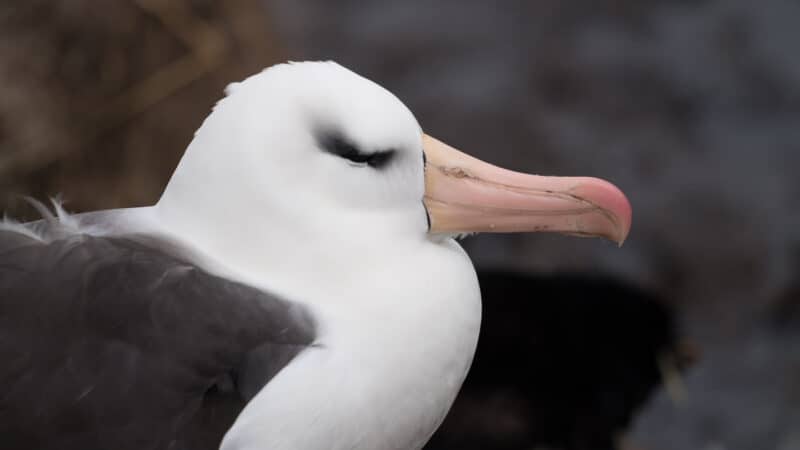
Albatross Colony – The main draw to the island is the huge colony of Black Browed Albatross that have their nests set just in front of some stunning rock formations. These birds build impressively large nests out of clay shaped like a pot.
The birds didn’t seem to mind our presence. The albatross carried on with everyday life, with us standing just a few feet away. We were so close we were almost in the landing pattern. You can find a constant rotation of albatrosses coming and going from the colony.
They are regal and impressive birds while on the nest and in the air, but they lack some grace when coming in for a landing. They swoop in with their big webbed feet outstretched like a plane with oversized landing gear, making clunky adjustments as they line up their less-than-graceful landings.
Rock Hoppers – The albatross might be the headliners here, but rockhopper penguins are my personal favorite penguins. I just love their big, bushy yellow eyebrows and pudgy physique. Living side by side with the albatross, the rockhoppers have built their nest at ground level.
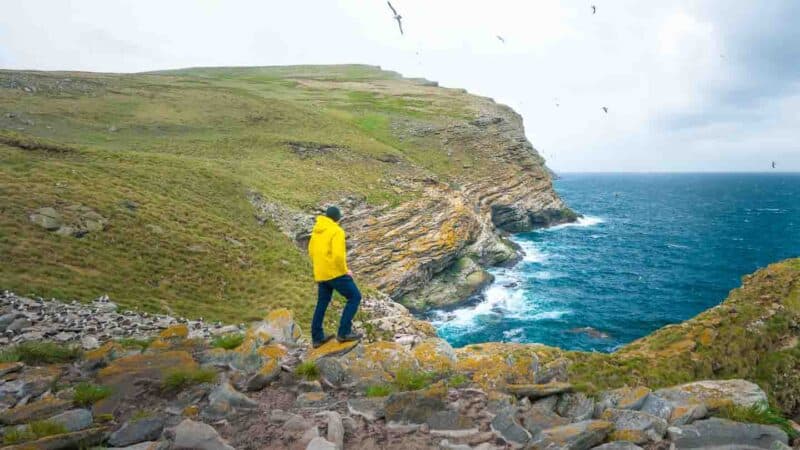
Rock Formations – Even if these cliffs weren’t covered in albatross, they would still be worthy of a visit. Springing out of the sea a few hundred feet, the rugged rock walls are topped with bright green grass and drop straight off into the sea.
Sea Lion Island (2-3 Nights)
It’s hard to pick a favorite stop in the Falklands, but Sea Lion Island would be high on that list. This small island is teeming with wildlife. In the small footprint of Sea Lion Island, you can see most of the Falklands’ most interesting species. In addition to the animals, you can spot that the landscape is also dramatic and varied.
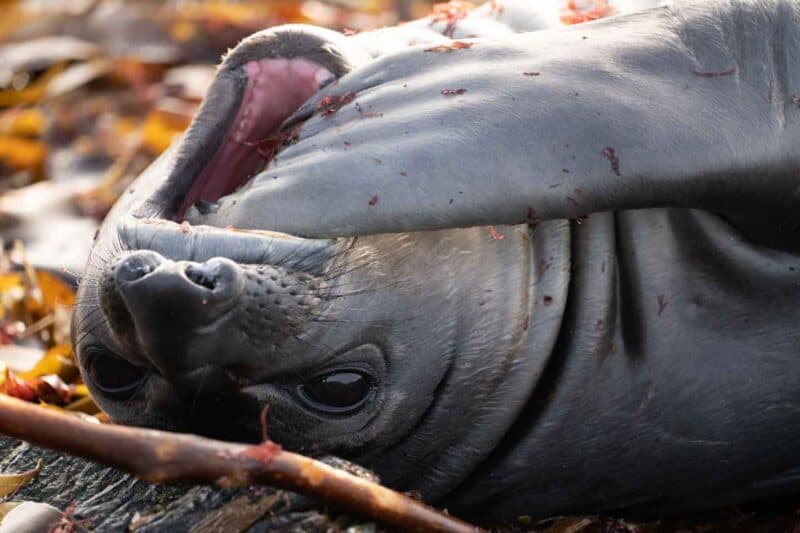
Sunrise on the Northern Beach – I am more of a sunset person, but here, I made sure to set an alarm to wake up with the sun and spend the morning on the beach. During this time of the day, the soft light is very nice for photos, and I came back with some of my favorite shots of the trip. The elephant seals and penguins must have also set their alarms because they were all out playing on the beach.
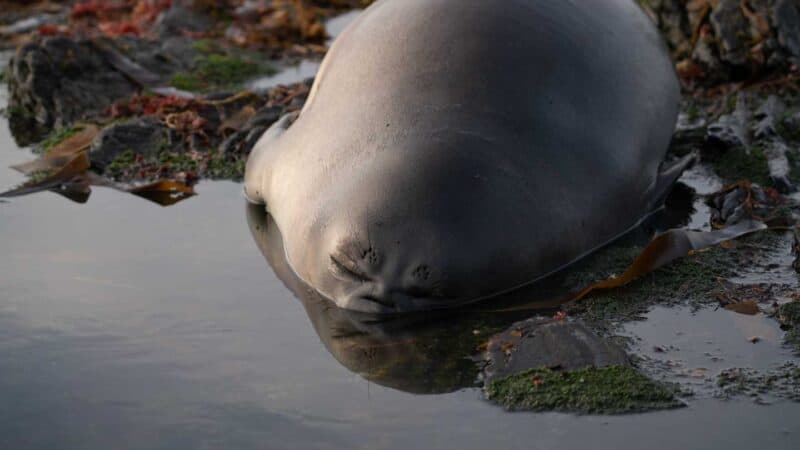
Orca Pools – One of the main reasons I woke up early every morning here is because of a few shallow inlets locally known as the Orca Pools. The Orcas or Killer Whales here have devised a unique technique to hunt seals here on Se Lion Island.
When the tide is right, the pools created by rocks fill just enough for an orca to swim in and catch a seal pup splashing around in the shallow waters. It’s usually known to happen in the mornings, but it’s rare to see it happen. We did, however, see a few tall dorsal fins lurking around the pools, but we didn’t get to see this amazing feat in person.
Elephant Seals – The locals jokingly say the island should have been named Elephant Seal Island because the beaches are absolutely covered in them. They outnumber the sea lions substantially and have become one of the main draws to the islands.
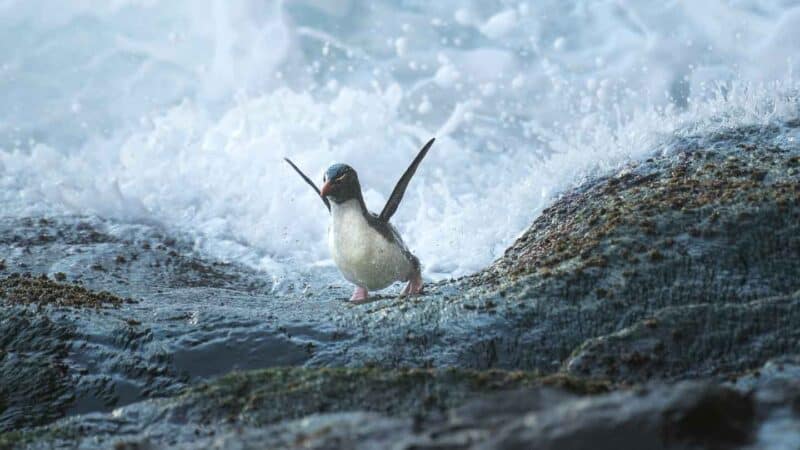
Rockhopper Penguins – We spent hours just watching the rockhoppers come and go from fishing. Making it out to sea and back is no easy task for the rockhopper penguins in Sea Lion Island. They have to make their way up and down a tall, steep cliff with waves crashing against a rock wall.
It was amazing to watch them do it. For as chubby and unathletic as they look, they are actually amazing animals, you end up cheering for them to make it back up and fight against the odds.
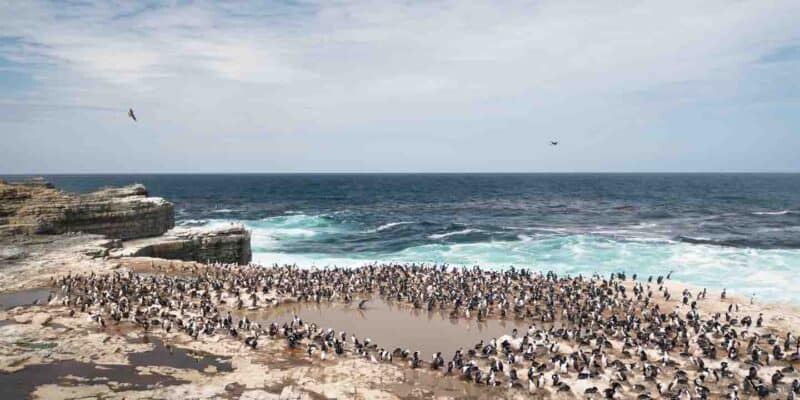
Cormorants – On Sea Lion Islands, the cormorants have one of the most picturesque homes on the island. They’ve chosen to form a colony on the top of a rugged cliff overlooking the sea. The rocks here have split and cracked, creating all sorts of interesting formations, and it’s amazing to take photos from up here.
Rocky cliffs on the north – The central northern shores of Sea Lion Islands are bordered by tall dramatic cliffs dropping sharply into the sea. They are home to all kinds of birdlife and some great wildlife viewing. In addition to the animals that live here, the rock formations themselves are quite impressive and picturesque – a must visit while on Sea Lion Island.
Gentoo Penguin Colonies – Well inland, several colonies of gentoo penguins have built their nests and were patiently waiting for their eggs to hatch during our early December visit.
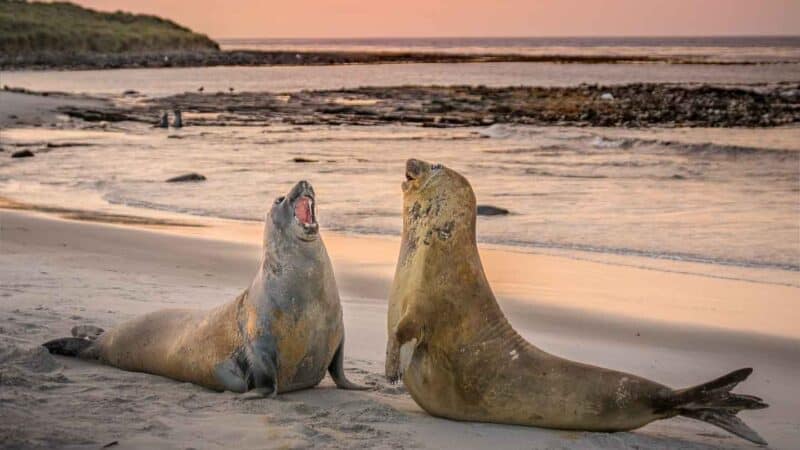
Sunsets on the Beach – Another special time on Sea Lion Island is sunset. In the hours before dark, many of the penguins are coming in from fishing and seals, and their pups are gathered on the beach in large numbers. The soft light at the end of the day makes for another great photo opportunity. We had a few spectacular sunsets during our time here, with pastel skies and active wildlife.
So active, we were stuck on the beach for an hour longer than expected, caught between watching two adult elephant seals battling and our path back to the lodge. We didn’t mind a little bit of a Falklands-style traffic jamb at the end of the day, and we got some great photos of the action.
Evenings at the Lodge – One of the aspects I grew to really enjoy was the time after the sun had set and everyone visiting the island gathering for dinner. The conversations that came from our time in the lodge I really enjoyed. You are surrounded by people from around the world, all with common interests in wildlife, photography, and travel.
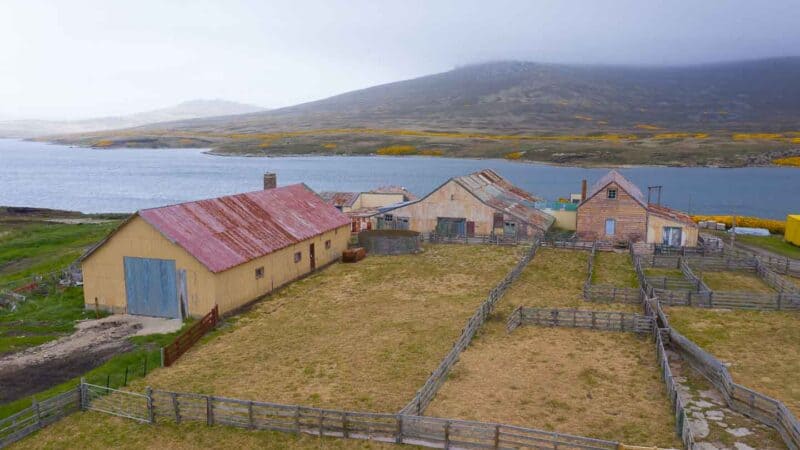
Weddell Island (2 Nights)
The largest island after East and West Falkland is Weddell Island in the far west of the archipelago. Weddell Island is roughly five times larger than Manhattan and is reportedly the largest privately owned island in the entire world. During the time of our visit, there were three people here. The sense of remoteness found in Weddell Island is going to be hard to top.
In addition to having such a huge space virtually all to yourself, the other appeal here is the unique species found on the island. One of the original owners of the island, in which it gets its namesake, introduced a lot of exotic species to the island, some of which are still around nearly 100 years later. Some of the most famous residents are the Patagonian foxes and Reindeer.
Highlights of Weddell Island
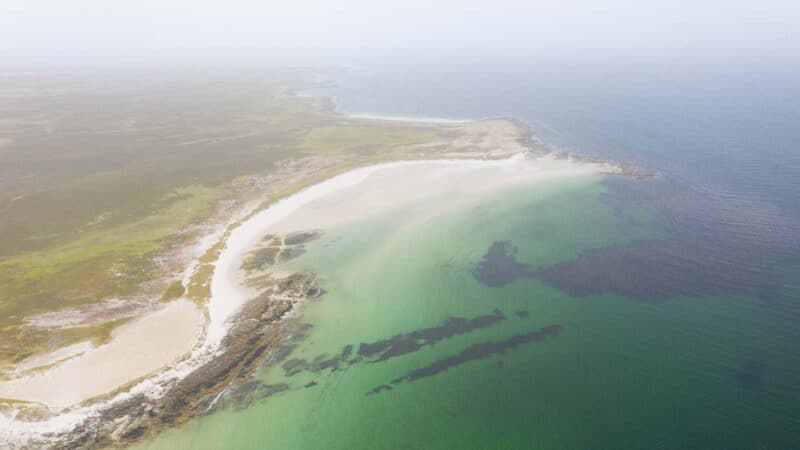
Loop Head – Walking the beaches on the northeast peninsula, known locally as the Loop Head, feels like you are walking on beaches that haven’t seen human footprints in a long, long time. Green grass pastures with sheep gazing on top of short bluffs give way to white sand beaches and turquoise waters.
Mount Weddell – Impressive to look at and intense to climb, towering over the old settlement is Mount Weddell. In November and December, the base of the mountain is covered in bright yellow gorse that gives way to patches of green grass and massive stone runs scattered in between. If you stare long enough at the piles of gray rocks, you can begin to see shapes like whales and other imaginary figures.
Patagonian Foxes – A highlight of any trip to Weddell Island is to spot a fox. Found only on Weddell Island (fortunately or unfortunately) due to being introduced by humans, the Patagonian foxes can still be found around the island. We found a few in the distance from the seat of the Land Rover, but they were a bit too quick to get a good shot of them.
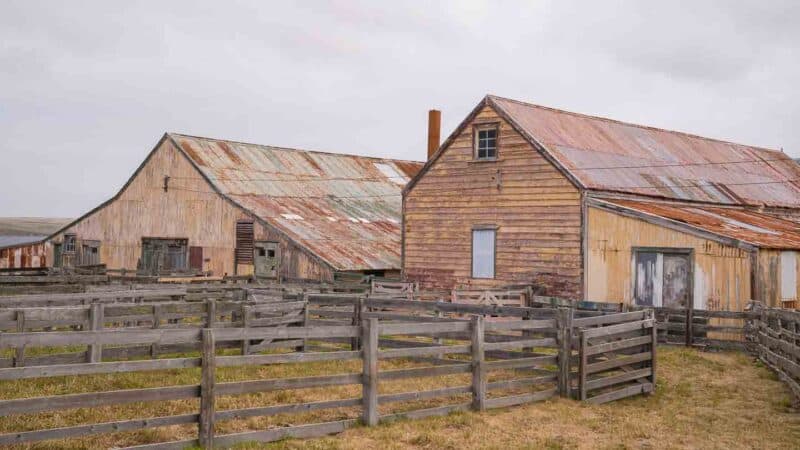
Old Farm Buildings – One of my favorite parts of Weddell Island was the old farm buildings. The colorfully painted wooden buildings had just the right amount of wear and peeling paint that made them super photogenic.
Volunteer Point – (Day Trip From Stanley)
With a trip full of amazing wildlife experiences, our day trip to Volunteer Point was a highlight among the highlights of our trip to the Falkland Islands. The beautiful King Penguins in this beautiful setting is a wildlife encounter of a lifetime.
Make sure to read our detailed Volunteer Point guide and see all the amazing wildlife we saw. Volunteer Point is the highlight for those visiting the Falklands on an Antarctica cruise. Tours sell out fast. We recommend booking this tour in advance to secure a spot.
Highlights of a trip to Volunteer Point
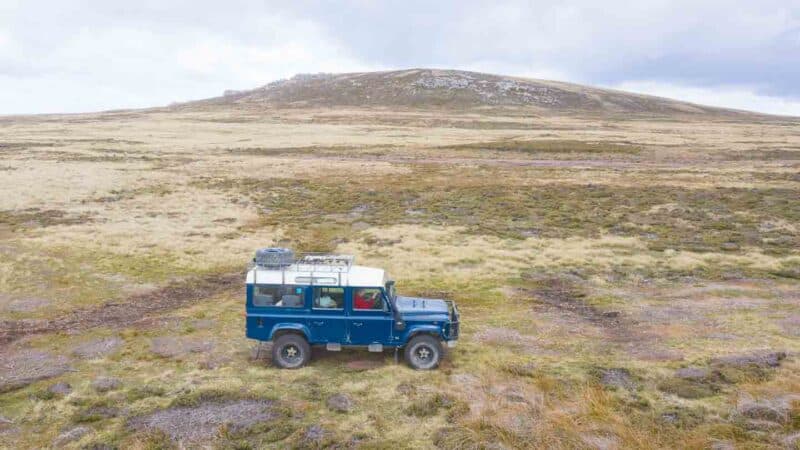
The Drive – Notorious among locals and visitors that have made the journey, the road, or lack thereof, is part of the experience of visiting Volunteer Point. From Stanley, the ride will take you around 2-2:30 hours.
The first 30 minutes from Stanley is easy on a well-maintained gravel road, but things quickly change to a bumpy and boggy track through a sheep farm on the way to Volunteer Point. Even the best drivers occasionally get ‘bogged,’ stranding their highly capable Land Rovers in the muddy peat bogs up to the top tread of their tires.
The landowners have no intention of making the road any better than it is. It’s part of the experience, and it makes seeing the king penguins even more special once you make it there. Embrace the journey. If you happen to get bogged down, help is never too far away – plus, you have a story to tell back home.
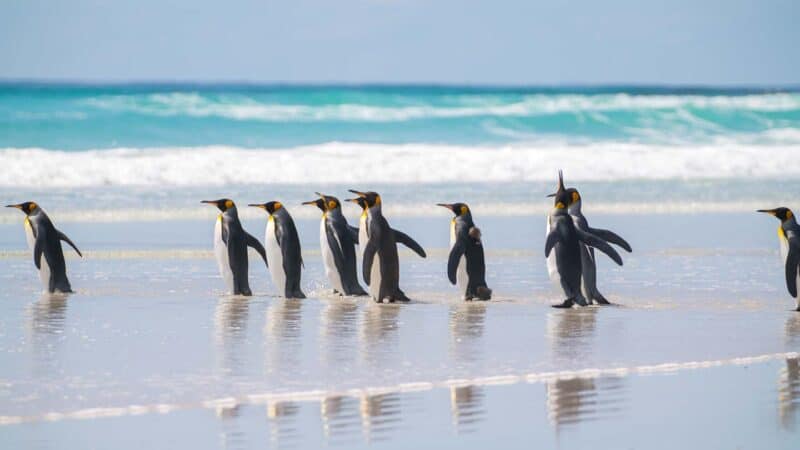
King Penguins on the Beach – This is the perfect vision of the Falklands King penguins waddling down the white sand beach and diving into turquoise waters. Volunteer Point is nothing short of magical.
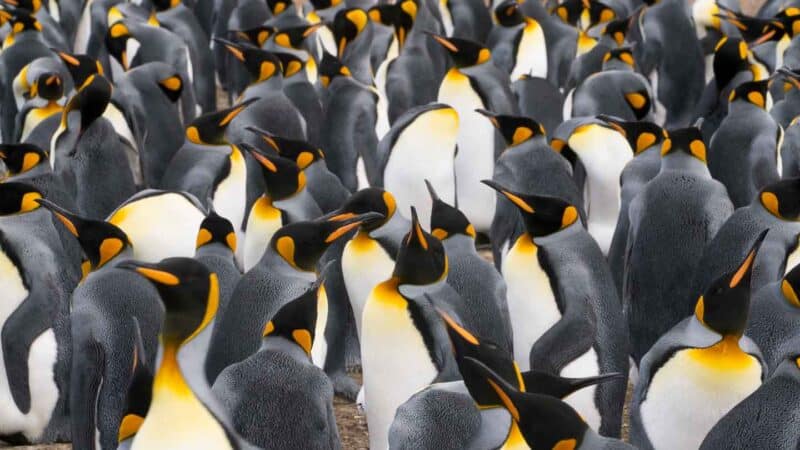
King Penguin Rookery – Following the squawking, your ears will lead you to an area just inland from the beach that the King penguins have chosen for nesting grounds. Here, you’ll find hundreds, even thousands of penguins.
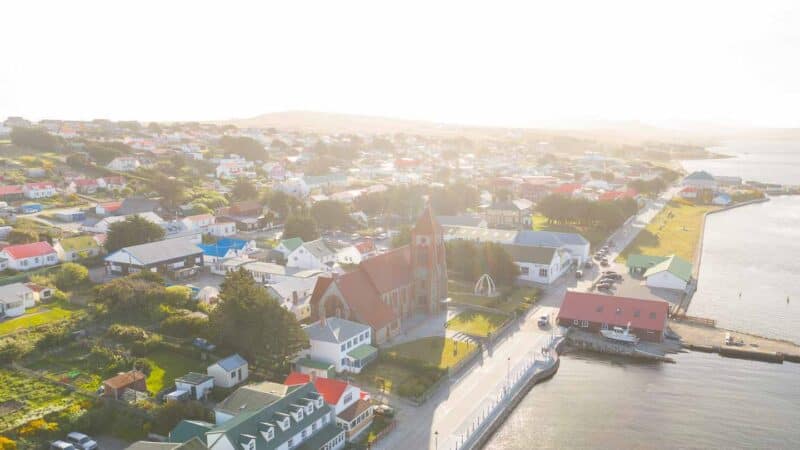
Stanley (3-4 Days)
The last stop of our two weeks in the Falklands was to the big city of Stanley. Over 90% of the population lives in Stanley, which is around 3,000 residents. However, just because it’s the biggest city doesn’t mean there aren’t plenty of adventures and things to do in and around Stanley.
It’s best to plan your time in Stanley toward the end of your trip so you are in town and ready to make your flight out of the Falklands from the main Mt. Pleasant Airport.
3-4 days might seem like a lot of time for the main city, but you’ll want about that much time to see everything here, especially if you take a day trip to Volunteer Point, which we highly recommend.
Best Stanley & Berthas Beach Private Tour
Stanley Highlights
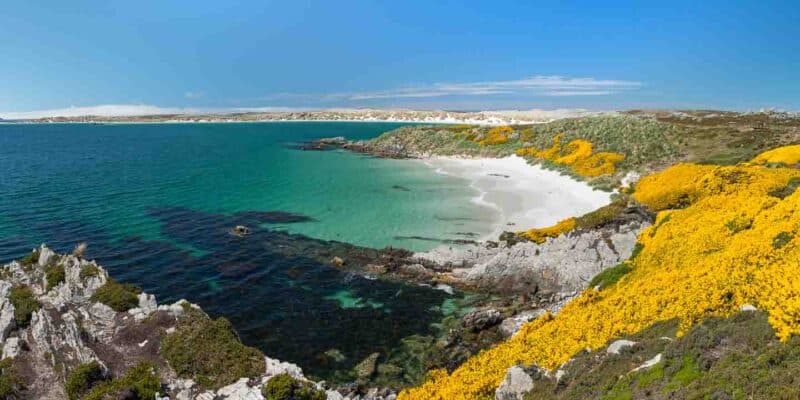
Gypsy Cove – One of the top sights in Stanley is the stunning white sand beach and turquoise waters of Gypsy Cove. This is my favorite tour in Stanley. It is a private tour where you pay one price for the whole vehicle, not per person. It visits some of the best things to do in the Falkland Islands: Gypsy Cove, Bertha’s Beach, Yorke Bay, Lady Elizabeth Shipwreck, and Stanley city tour.
If you visit in November and December, the hills should be covered in bright yellow gorse, adding an extra pop of color to your photos. Here, you’ll also find plenty of Magellanic Penguins nesting in the hills and sunning on the beach.
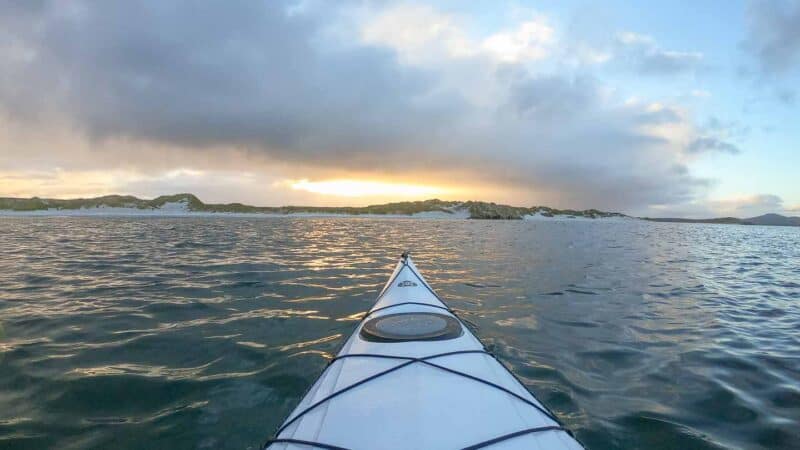
Sea Kayaking – One of my favorite adventures we went on in the Falklands was a sea kayaking trip around the islands near Stanley with Dan from Falkland Outdoors. We cruised around the uninhabited islands near the city and found curious sea lions, great landscapes, and plenty of wildlife.
We also took our kayaks up to the beach of Gypsy Cove for another angle at this famous spot. Check out this and other tours offered by Falklands Outdoors.
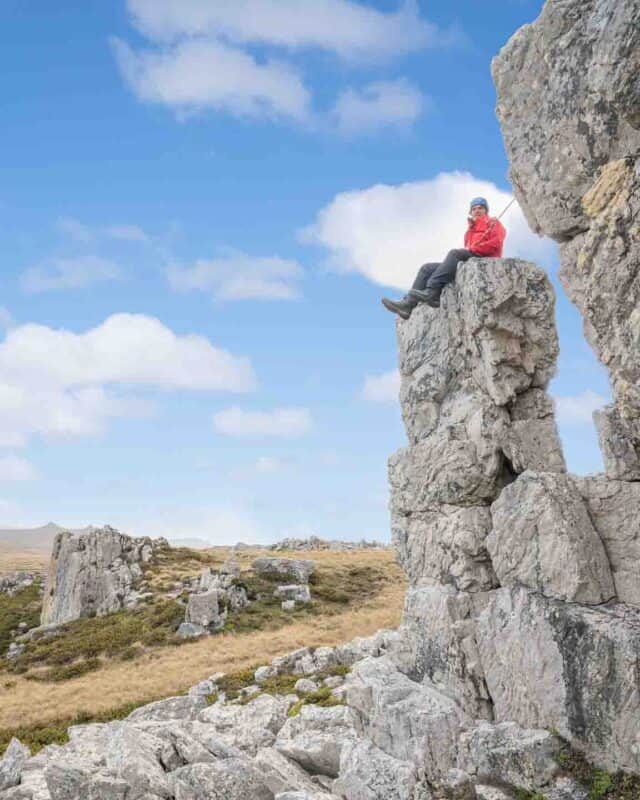
Rock Climbing in the Stanley Mountains – Another adventurous thing to do in Stanley is to gear up and go rock climbing in the mountains just outside the city. Many of the mountains in the Falklands are topped with outcroppings of rocks that are perfect for climbing. This is another adventure tour offered by Falklands Outdoors worth putting on your list of things to do in the Falklands.
Visit the Stanley Museum – The Historical Dockside Museum – A stop here will give you a great insight into the history of the islands, which is probably even more interesting than you expected. Don’t miss the Video on the Falklands War. It helps to put a voice and picture behind the things that happened here.
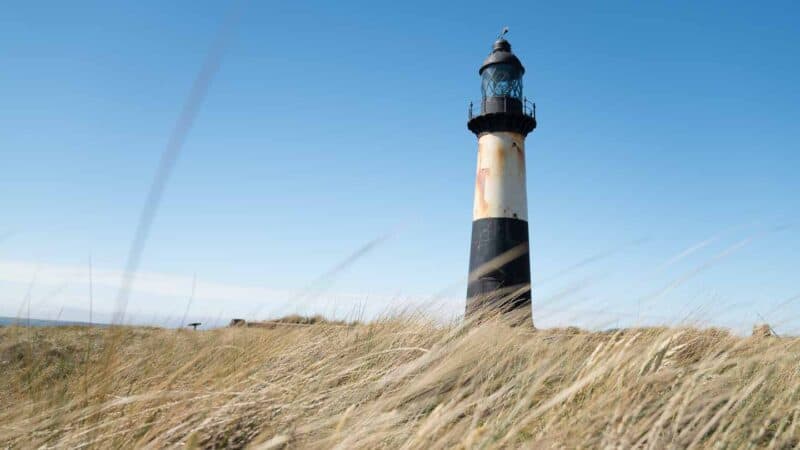
Cape Pembrook – Another great stop in Stanley is the lighthouse of Cape Pembrook. Here, you’ll find a classic white and black lighthouse that guided many ships safely in and out of the Falklands. It was damaged in the war and has since been retired, but it still stands as a symbol of the maritime heritage of the islands.
Stanley Mountains Battle Field Tour – A hike up Mt. Longden is a slow, gradual climb back into the year of 1982. Here, high in the hills outside of Stanley, you can still see many reminders of the war scattered about.
Visit the Lady Elizabeth Ship Wreck – Scattered around the harbor in Stanley are a few old shipwrecks that were damaged while sailing and laid to rest here. In earlier times, they were placed in the harbor and used for storage.
Most have broken down over the years, but the iron ‘Lady Liz,’ as the locals call her, is the last relatively intact hull still standing. There are two more wrecks that are closer to town, but there isn’t much left from their wooden hulls above the surface anymore.
If you want to visit Lady Elizabeth Shipwreck and some Stanley attractions, including Gentoo penguins, Magellanic Penguins, King Penguins, and more. We suggest booking this Stanley Falkland Islands tour, which visits all those Falkland attractions.
Further Travel Information and Tips for Visiting Falklands
Wi-Fi in the Falklands for Visitors
The main source of internet in the Falklands comes from prepaid internet cards that can be purchased in several places in Stanley and a select few of the settlements. Most of the lodges I visited had a hotspot to connect to the internet.
For 5 Falkland Islands Pounds, you could connect for 45 minutes. The service seemed to be totally dependent on time rather than data usage. So, to conserve your credits, you can type messages and emails before connecting and send them after logging in.
Once connected, the internet speeds were usable, faster than I had expected. I could complete most tasks online and even send pictures and short video clips. However, connecting seemed to be the issue. There are apparently only so many slots, and once those are filled, you won’t be able to connect. I found it difficult to connect, but especially just after work hours, around 5-7 p.m. seemed to be the worst.
The cards work by connecting to a hotspot and then entering the serial number and passcode revealed by a scratch-off panel on the back of the card. You may log on and off with the cards using your 45 minutes.
Best Weather Apps and Forecasts in the Falkland Islands
Weather forecasts are hard to come by at the ends of the earth, but there are a few good apps you should use to get some pretty accurate information.
Don’t Forget to Pin Me for Later
